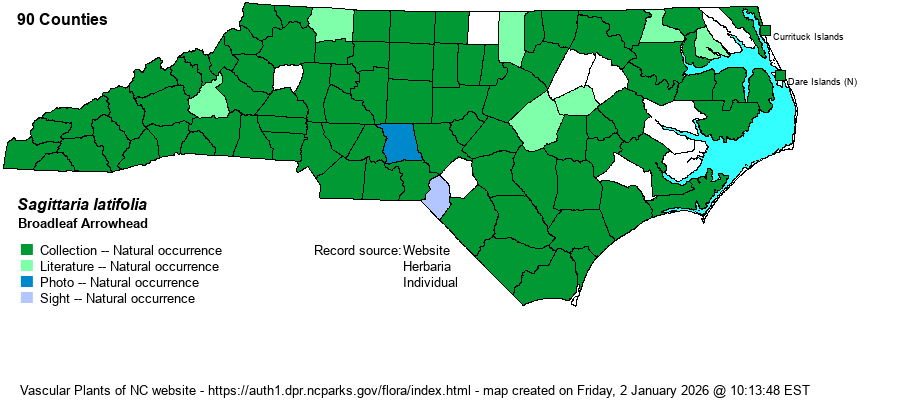| Author | Willdenow | |
| Distribution | Occurs statewide, probably present in all 100 counties, though there are few records for the northeastern counties. The taxon editors have re-examined specimens at NCU and online at SERNEC, and have placed them into var. latifolia (including var. obtusa) and var. pubescens. See the distribution maps for each.
This is the most widespread species of Sagittaria, both in NC and in the country. It occurs over most of Canada and the U.S. | |
| Abundance | Frequent to common, and widespread, over nearly all of the state. It is the only one of the state's 14 species in the genus to be given a State Rank of S5. | |
| Habitat | This is one of the more widespread broad-leaved marsh species, it being found in mostly nutrient-rich soils of lake and pond margins, marshes, openings in swamps, ditches, bogs, impoundments, and beaver ponds. It favors brownwater sites as opposed to blackwater (more acidic) ones, but can be found in both. |
| Phenology | Blooms from June to October, and fruits shortly after flowering. | |
| Identification | This is the "standard" arrowhead, the one that nearly everyone has seen. It has several leaves, each with a long stalk to over 1 foot long; this stalk (petiole) is triangular in cross-section. It has an arrowhead-shaped leaf blade 6-8 inches long and usually about 1/2 as wide, but the width is rather variable. The blades have two long-pointed bases that come to an acute apex. The flower stalk grows to about 1.5-2 feet tall and has 2-10 whorls of large white flowers along this stem, each flower having 3 petals and being about 1 inch across. The flower bracts are shorter in this species, only about 1/3-inch long and boat-shaped; those of the similar S. australis are longer, often closer to 2/3-1-inch long, and are not boat-shaped and also are papery and tan in color. You may need to check the leaf stalk with your fingers; this species has 3-sided stalks whereas S. australis has sharply 5-sided leaf stalks. You may need to check other references for seed characters. But, this is by far the commoner of the two Piedmont and northern Coastal Plain arrowhead-shaped Sagittaria species, often found easily along a shoreline of a pond or lake where marshy. | |
| Taxonomic Comments | Weakley (2018) and some other referecnes not surprisingly list several varieties for the species, given its huge range. He lists the nominate one -- S. latifolia var. latifolia as well as S. latifolia var. pubescens. Both are numerous and widespread in the state.
| |
| Other Common Name(s) | Common Arrowhead, Duck Potato | |
| State Rank | S5 | |
| Global Rank | G5 | |
| State Status | | |
| US Status | | |
| USACE-agcp | OBL link |
| USACE-emp | OBL link |

